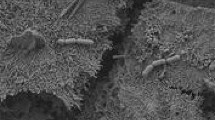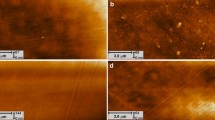Abstract
The ability of organisms to adhere to and form biofilms on fibrous materials is believed to be an important initiating step in the induction of several diseases, such as toxic shock syndrome. Using anin vitro assay, a moderately hydrophobic strain ofStaphylococcus aureus (water contact angle 35°) and a hydrophilicCandida albicans (shown by a hexadecane test) were highly adherent to commercial diaper fibers. The lumen side of the diaper was porous and the fibers were very hydrophobic (>140°), but the internal section was very hydrophilic (0°), presumably for adsorption purposes. There was evidence that adhesion of the pathogens was inhibited when one of fiveLactobacillus strains was present. Surfaces precoated with lactobacilli inhibited staphylococcal adhesion by 26–97%, and candida by 0–67%. When the lactobacilli were used to challenge adherent pathogens, there was 99% displacement of theS. aureus and up to 91% displacement ofC. albicans. HydrophobicL. acidophilus 76 (54°) and T-13 (80°) were the most effective of fiveLactobacillus isolates tested at interference by precoating. The moderately hydrophilicL. casei varrhamnosus GR-1 (33°) was the most effective at displacing the yeast. Experiments with uroepithelial cells also showed that the lactobacilli could significantly interfere with the adhesion of both pathogens to the cells. The results demonstrate the rapidity with which two pathogens adhered to fibers and epithelial cells, and raised the possibility that members of the normal female urogenital flora might interfere with infections caused by these organisms.
Similar content being viewed by others
References
berg RW. 1988. Etiology and pathophysiology of diaper dermatitis. Adv Dermatol 3: 75–98.
Berkley SF, AW Hightower, CV Broome and AL Reingold. 1987. The relationship of tampon characteristics to menstrual toxic shock syndrome. JAMA 258: 917–920.
Branting C, ML Sund and LE Linder. 1989. The influence ofStreptococcus mutans on adhesion ofCandida albicans to acrylic surfacesin vitro. Arch Oral Biol 34: 347–353.
Brook I. 1992. Microbiology of secondarily infected diaper dermatitis. Int J Dermatol 31: 700–702.
Bruce AW, G Reid, JA McGroarty, M Taylor and C Preston. 1992. Preliminary study on the prevention of recurrent urinary tract infections in ten adult women using intravaginal lactobacilli. Int Urogynecol J 3: 22–25.
Chow AW, KH Bartlett and AM Goldring. 1984. Quantitative vaginal microflora in women convalescent from toxic shock syndrome and in healthy controls. Infect Immun 44: 650–652.
Gokalp AS, C Aldirmaz, A Oguz, A Gultekin and MZ Bakici. 1990. Relation between the intestinal flora and diaper dermatitis in infancy. Trop Geogr Med 42: 238–240.
Hawthorn LA and G Reid. 1990. Exclusion of uropathogen adhesion to polymer surfaces byLactobacillus acidophilus. J Biomed Mater Res 24: 39–46.
Hazen KC, DL Brawner, MH Riesselman, MA Jutila and JE Cutler. 1991. Differential adherence of hydrophobic and hydrophilicCandida albicans yeast cells to mouse tissues. Infect Immun 59: 970–912.
Hilton E, HD Isenberg, P Alperstein, K France and MT Borenstein. 1992. Ingestion of yogurt containingLactobacillus acidophilus as prophylaxis for candidal vaginitis. Ann Inter Med 116: 353–357.
Kennedy MJ, AL Rogers and RJ Ynacey Jr. 1989. Environmental alteration and phenotypic regulation ofCandida albicans adhesion to plastic. Infect Immun 57: 3876–3881.
Keswick BH, JL Seymour and MC Milligan. 1987. Diaper area skin microflora of normal children and children with atopic dermatitis. J Clin Microbiol 25: 216–221.
Klotz SA. 1990. Adherence ofCandida albicans to components of the subendothelial extracellular matrix. FEMS Microbiol Lett 56: 249–254.
Klotz SA and RL Penn. 1987. Multiple mechanisms may contribute to the adherence ofCandida yeasts to living cells. Curr Microbiol 16: 119–122.
Lanes SF, C Poole, NA Dreyer and LL Lanza. 1986. Toxic shock syndrome, contraceptive methods, and vaginitis. Am J Obstet Gynecol 154: 989–991.
McMurdo MET, PG Davey, M-A Elder, RM Miller, DC Old and J Malek. 1992. A cost-effectiveness study of the management of intractable urinary incontinence by urinary catheterization or incontinence pads. Epidemiol Community Health 46: 222–226.
Michigan S. 1976. Genitourinary fungal infections. J Urol 116: 390–397.
Millsap K, G Reid, HC van der Mei and HJ Busscher. 1994. Displacement ofEnterococcus faecalis from hydrophobic and hydrophilic sustrata byLactobacillus andStreptococcus sp as studied in a parallel plate flow chamber. Appl Environ Microbiol 60: 1867–1874.
O'Connor MI and JD Sobel. 1986. Epidemiology of recurrent vulvovaginal candidiasis: identification and strain differentiation ofCandida albicans. J Infect Dis 154: 358–363.
Rasmussen JE. 1987. Classification of diaper dermatitis: an overview. Pediatrician 14 Suppl 1: 6–10.
Reid G. 1994. Applications from bacterial adhesion and biofilm studies in relation to urogenital tissues and biomaterials. A review. J. Ind Microbiol 13: 90–96.
Reid G. 1994. Microbial adhesion to biomaterials and infections of the urogenital tract. Coll Surfaces B: Biointer 2: 377–385.
Reid G, AW Bruce and M Taylor. 1992. Influence of three day antimicrobial therapy and lactobacillus suppositories on recurrence of urinary tract infection. Clin Therapeutics 14: 11–16.
Reid G, AW Bruce and M Taylor. 1995. Instillation of lactobacillus and stimulation of indigenous organisms to prevent recurrence of urinary tract infections. Microecol Ther (in press).
Reid G, RL Cook and AW Bruce. 1987. Examination of strains of lactobacilli for properties which may influence bacterial interference in the urinary tract. J Urol 138: 330–335.
Reid G, PL Cuperus, AW Bruce, L Tomeczek, HC van der Mei, AE Khoury and HJ Busscher. 1992. Comparison of contact angles and adhesion to hexadecane of urogenital, dairy and poultry lactobacilli: effect of serial culture passages. Appl Environ Microbiol 58: 1549–1553.
Reid G, D Lam, AW Bruce, HC van der Mei and HJ Busscher. 1994. Adhesion of lactobacilli to urinary catheters and diapers: effect of surface properties. J Biomed Mater Res 28: 731–734.
Reid G and C Tieszer. 1993. Preferential adhesion of bacteria from a mixed population to urinary catheters. Cells Mater 3: 171–176.
Rosenberg M. 1994. Bacterial adherence to hydrocarbons: a useful technique for studying cell surface hydrophobicity. FEMS Microbiol Lett 22: 289–295.
Tierno PM Jr and BA Hanna. 1985.In vitro amplification of toxic shock syndrome toxin-1 by intravaginal devices. Contraception 31: 185–194.
Tierno PM Jr and BA Hanna. 1989. Ecology of toxic shock syndrome: amplification of toxic shock syndrome toxin 1 by materials of medical interest. Rev Infect Dis 11 Suppl 1: S182-S186.
van der Mei HC, MM Cowan and HJ Busscher. 1992. Physico-chemical and structural studies onAcinetobacter calcoaceticus RAG-1 and MR-481. Two standard strains in hydrophobicity tests. Curr Microbiol 23: 337–341.
Vartivarian SE. 1992. Virulence properties and nonimmune pathogenetic mechanisms of fungi. Clin Infect Dis 14 Suppl 1: S30-S36.
Vasilas A, L Molina, M Hoffman and CG Haidaris. 1992. The influence of morphological variation ofCandida albicans adhesion to denture acrylic in vitro. Arch Oral Biol 37: 613–622.
Author information
Authors and Affiliations
Rights and permissions
About this article
Cite this article
Reid, G., Tieszer, C. & Lam, D. Influence of lactobacilli on the adhesion ofStaphylococcus aureus andCandida albicans to fibers and epithelial cells. Journal of Industrial Microbiology 15, 248–253 (1995). https://doi.org/10.1007/BF01569832
Received:
Accepted:
Issue Date:
DOI: https://doi.org/10.1007/BF01569832




